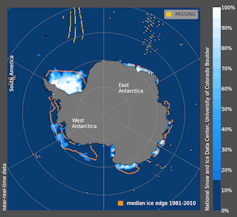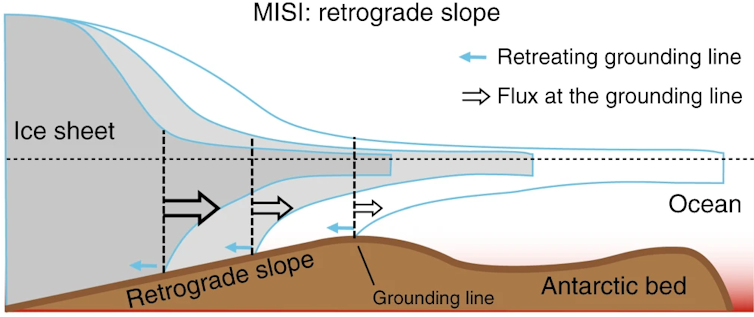The Antarctic ice sheet is melting. And this is bad news for humanity
Ottawa’s famous Rideau Canal, which turns into the world’s largest ice rink every winter, is too thin to open this winter.
Thousands of kilometres to the south, we can see a similar issue on a much larger scale in the Antarctic, where the sea ice is also struggling to form. The Antarctic sea ice extent — region with at least 15 per cent sea ice cover — reached a record low on Feb. 13.
While the mass of the Antarctic ice sheet has been decreasing for a long time, the Antarctic sea ice extent has been strongly decreasing since 2016.
If left unchecked, the complete melting of the West Antarctic ice sheet would cause a global sea level increase of 3.3 metres in the distant future.
The white continent
The ice-covered continent of Antarctica, surrounded by the Southern Ocean, holds 90 per cent of the world’s ice.
This mass of ice that forms the ice cover, or ice sheet, over land has resulted from the accumulation and compaction of the snow over thousands of years. And when it extends over the sea, it forms an ice shelf.
The Antarctic ice sheet comprises the West Antarctic ice sheet and the East Antarctic ice sheet. Most of the West Antarctic ice sheet is below the sea level. Around the Antarctic, the extent of the sea ice — which forms from ocean water — increases in winter and decreases in summer.
The Antarctic warms faster
The Antarctic is not free from climate change. On the contrary, the rise in temperatures at high latitudes is much stronger than the rise in the global mean temperature. This phenomenon is known as polar amplification.
This phenomenon can be explained by the ice-albedo feedback. The increase in the near-surface temperature contributes to the melting of the ice, which contributes to the increase in the temperature. Why? Because the albedo — the fraction of solar energy that is reflected by a surface — of the ocean and of the ground underneath is lower than that of the ice.
Over the last four decades, climate change has caused a decrease in the average extent of sea ice in the Arctic, but not in the Antarctic. The reason for this statistically insignificant decrease in the average Antarctic sea ice extent is the regional tendencies — the sea ice extent has increased in some regions and decreased in others — compensate for each other. Another reason is the strong internal variability.
However, the Antarctic sea ice extent has decreased a lot since 2016. The decrease in the surface of the sea ice cover contributes to the increase in the temperature, but not to sea level rise. This is because the volume of water that the ice displaces when it forms is the same as it adds to the ocean when it melts. As for the Antarctic ice sheet, its mass has decreased since at least 1990, with the highest loss rate during the last decade.
In its Sixth Assessment Report, the Intergovernmental Panel on Climate Change (IPCC) found that, in the Antarctic, temperature will continue to increase and the mass of the ice sheet will continue to decrease. The growth of this ice sheet is much slower than its retreat, which means that, if it continues to melt during this century, this melting will not be reversible at a human time scale.
The degree of confidence in the climate projections surrounding the Antarctic sea ice is weak, as the climate model simulations do not accurately capture its observed evolution. And so, we cannot make any definitive conclusions about it.
The consequences of the collapsing ice sheet
The sustained melting of the West Antarctic ice sheet could indicate that an unstable retreat (which reinforces itself) is underway or imminent. However, there is high uncertainty about this phenomenon.
The mechanism that would explain this unstable retreat is known as Marine Ice Sheet Instability.
If the bed, where the ice sheet lies, slopes down towards the interior, it destabilizes the position of the grounding line — zone where this ice sheet starts to float. The thinning of the ice shelf causes this grounding line to retreat, which leads to an influx of ice from the ice sheet to the sea. This, subsequently, causes the thinning of the ice shelf and so on and so forth.
Schema showing the Marine Ice Sheet Instability (MSI) process. The blue arrows indicate the retreat of the grounding line, and the white arrows indicate the ice flux. (Pattyn, F. The paradigm shift in Antarctic ice sheet modelling. Nat Commun 9, 2728 (2018)), CC BY-SA
At present, the world is heading towards a warming of 2.8 C by the end of this century. A sustained warming of about 2 C to 3 C would be sufficient to make this ice sheet almost completely disappear, but this phenomenon would take thousands of years.
The bottom line is that the melting of the Antarctic ice sheet contributes to and will continue to contribute to sea level rise for a long time, which will test the adaptive capacity of humanity.
The sea level increase by 2100 will particularly affect the tropical countries. And so, what happens in the Antarctic will definitely not stay in the Antarctic.
![]()

